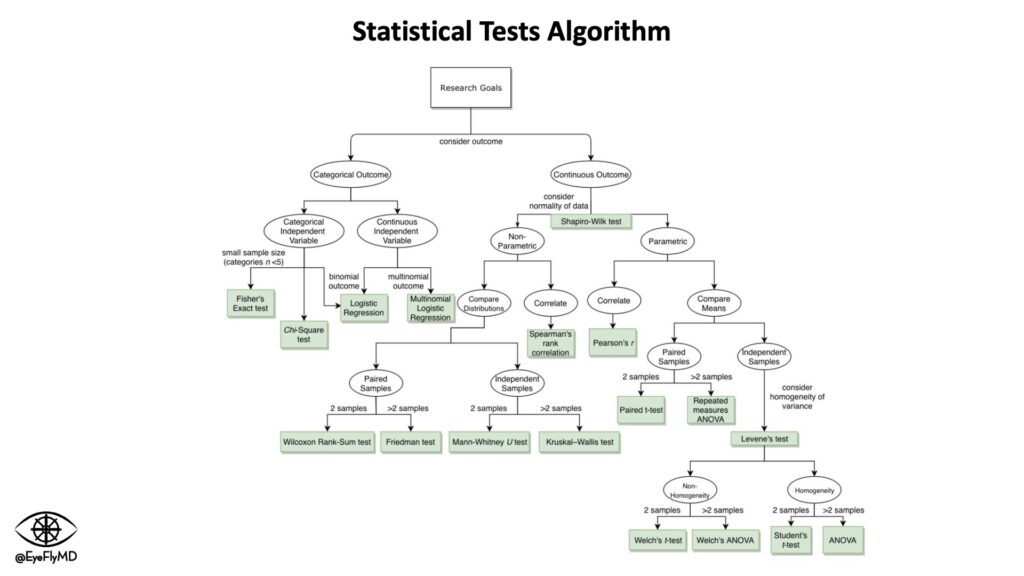Research Resources
Here you can find resources I’ve made or general advice regarding research.
Here is a paper our team published on the use of biostatistics in ophthalmology. We believe it is possible for many researchers (including students) to independently perform their own statistical analysis. This has the added benefit of allowing greater understanding of the research question and avoid ideas being lost in the process. This paper covers approaching biostatistics in the context of ophthalmology for small, retrospective studies. Larger RCTs of course require very sophisticated statistical analysis but we believe there is value in pragmatic chart reviews as well.

General Approach to Research
When I work with medical students, I like to follow this general approach and have them fill out the template below. I also received excellent advice at one point which said when formulating a research project it’s important to have an idea of what the tables and figures will be. This is good advice because it not only helps to guide the goals and objectives of the study but also helps with workflow as you can complete the pre-made tables as the project progresses. I like this method because it also helps avoid going down tangents during the research process and keeps manuscript/poster very focused to the original objectives. Also having target journals in mind can help too.
Research Idea Template
Objective: What is the overall purpose of the study?
Importance: Why is it relevant?
Background: What is the background of the topic or what is already known?
Method: How will the research be accomplished? What data needs to be collected?
Inclusion Criteria: Which patients will specifically be included?
Exclusion Criteria: Which patients will be excluded because they may confound the results?
Outcome Measures: Very specifically list the primary and secondary outcome measures.
Statistical Analysis: Which tests will be used to answer the research question?
Example
Objective: To determine the predictive factors for Selective Laser Trabeculoplasty (SLT).
Importance: SLT is becoming more popular as a first line treatment for glaucoma with the recent LiGHT trial. There are liminited large studies evaluating the predictive factors for a good outcome and it is important to know what characteristics are associated with success to tailor treatment plans to individual patients.
Background: SLT has proven safety and efficacy but there are limited studies with large sample sizes evaluating factors associated with a successful outcome.
Method: A retrospective chart review of glaucoma patients who had SLT and no additional laser or incisional surgeries in the following 12 months and who have at least 6 months follow-up. Baseline patient data will be collected to determine the relationship between Age, Type of Glaucoma, Severity of Glaucoma, Pigmentation of the TM, Baseline IOP, Total Energy Delivery, and Degree of Treatment and rate of success.
Inclusion Criteria: Glaucoma patients who have had SLT and at least 6 months follow-up.
Exclusion Criteria: Any patient who had additional laser or incision surgery at any point in the follow-up period.
Outcome Measures: Primary Outcome Measure: Relationship between patient characteristics and Success as defined by final IOP < 18 mmHg AND > 20% IOP reduction OR > 1 medication class reduction. Secondary Outcome Measures: Mean IOP reduction in mmHg and medication class reduction. Relationship between patient characteristics and post-operative IOP spikes defined as elevation of > 5 mmHg.
Statistical Analysis: Paired t-tests will be used to compare preoperative and postoperative IOP. A mixed model (age and preoperative IOP) and logistic regression (type and severity of glaucoma, pigmentation of the trabecular meshwork, total energy, and angle of treatment) will be used for determining predictive factors of success. Independent t-tests and Wilcoxon signed rank test will be used to compare IOP and medication reduction based on preoperative IOP and a Mann-Whitney U test to compare total energy delivery between light and dense PTM groups. An independent t– and chi-square/Fisher’s exact tests to assess associations between factors and IOP spike.
Selecting A Journal
A tangible outcome is always the desire of research. There are conferences throughout the year to present posters. Here is a list of journals that are considered by some metrics to be first or second quartile with regard to impact factor and are realistic for smaller, retrospective studies.
Always try at least one high impact factor journal first (Ophthalmology, Ophthalmology Glaucoma, British Journal of Ophthalmology, Eye, American Journal of Ophthalmology) and then try some of these lower 1st or 2nd quartile journals that are still high impact factor but are more appropriate for the studies we often do.
| Journal | Comments |
| Clinical Ophthalmology | Needs funding source, often can be company that makes new product we study |
| Journal of Current Glaucoma Practice | |
| Journal of Current Ophthalmology | |
| European Journal of Ophthalmology | |
| Ophthalmic Surgery, Lasers and Imaging Retina | |
| European Journal of Ophthalmology | |
| Journal of Academic Ophthalmology | |
